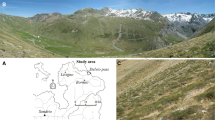Summary
Previous studies have shown that in Chile the so called mature matorral can have the form of either a continuous matrix of shrubs (wet sites) or of multispecific clumps of shrubs (dry sites). After clearing, sites are known to be initially covered by annuals and then byBaccharis spp. orAcacia caven shrubs. Further vegetation changes are still not documented. In the first part of this contribution we show evidence indicating that the “seed rain” of plants dispersed by birds is important only around bird perches and that in general “seed shadows” of mature matorral shrubs are small. These results suggest that late recolonization of cleared areas occurs by a slow diffusion process in which the presence of perching sites for birds plays a significant role. Then we exhibit results regarding the importance of seasonal droughts and European rabbits in explaining transitions between the various types of plant cover. Here we conclude that nursing by older shrubs and not by rocks or fallen branches, is a requirement to insure the survival of seedlings belonging to mature matorral shrubs. Nurses are important regarding both summer desiccation and herbivory. These nurse effects seem to be more important at dry sites where rabbits are also more numerous, than at wet sites where conditions seem somewhat milder and vegetation change could be faster. In the last part we discuss a scheme of vegetation change that incorporates these processes and explains the relation between them, the vegetation types and the recolonization of wet and dry areas. Finally, a brief mention is made to the difference between these processes and the comparable ones in the California chaparral.
Similar content being viewed by others
References
Bahre C (1972) IBP Chile-California Project Technical Reports. Mimeo
Cody ML, Mooney HA (1978) Convergence versus non-convergence in Mediterranean climate ecosystems. Ann Rev Ecol Syst 9:265–321
Di Castri F (1975) Esbozo Ecológico de Chile. Ministerio de Educación, Centro de Perfeccionamiento Experimental e Investigaciones Pedagógicas. Santiago, Chile
Fuentes ER, Jaksić FM (1980) Consideraciones teóricas para el control biológico del conejo. Medio Ambiente 2:45–49
Fuentes ER, Simonetti J (1982) Plant patterning in the Chilean matorral: are the roles of native and exotic mammals different? In: Conrad CE, Oechel WC (eds). Proceedings of the Symposium on Dynamics and Management of Mediterranean type ecosystems (1981) San Diego, California, Pacific Southwest Forest and Range Experiment Station. Berkeley, California, USA, pp 227–233
Fuentes ER, Jaksić F, Simonetti J (1983) European rabbits vs. native mammals: effects on shrub seedlings. Oecologia (Berlin) 58:411–414
Fuentes ER, Otaíza RD, Alliende MC, Hoffmann AJ, Poiani A (1984a) Shrub clumps of the Chilean matorral vegetation: structure and possible maintenance mechanisms. Oecologia (Berlin) 42:405–411
Fuentes ER, Espinosa GA, Fuenzalida I (1984b) Cambios vegetacionales recientes y percepción ambiental: el caso de Santiago de Chile. Revista de Geografía Norte Grande 11:45–54
Gutiérrez JR, Armesto J (1981) El rol del ganado en la dispersión de semillas deAcacia caven. Ciencia e Investigación Agraria 8:3–8
Gutiérrez JR, Fuentes ER (1979) Evidence for intraspecific competition in theAcacia caven (Leuminosae) savanna of Chile. Oecologia (Berlin) Plantarum 14:149–156
Hanes TL (1971) Succession after fires in the chaparral of southern California. Ecological Monographs 41:27–52
Hoffman AJ, Walker MJ (1980) Growth habits and phenology of a drought deciduous species in an altitudinal gradient. Canadian J of Botany 58:1789–1796
Jaksić FM, Soriguer RC (1981) Predation upon the European rabbit (Oryctolagus cuniculus) in mediterranean habitats of Chile and Spain: a comparative analysis. J of Animal Ecol 50:269–281
Keeley SC, Johnson AW (1977) A comparison of the pattern of herb and shrub growth in comparable sites in Chile and California. American Midland Naturalist 97:120–132
Mooney HA (1977) Convergent evolution in Chile and California mediterranean climate ecosystems. Dowden Hutchinson and Ross, Stroudsbourg, PA, USA
Olivares A, Gastó J (1971) Comunidades terófitas de subseres postaradura y en exclusión con la estepa deAcacia caven (Mol.) Hook et Arn. Santiago. Universidad de Chile, Facultad de Agronomía, Boletín Técnico N° 34, p 24
Thrower N, Bradbury D (1977) Chile-California Mediterranean scrub atlas. Dowden, Hutchinson and Ross. Stroudsbourg, PA, USA
Author information
Authors and Affiliations
Rights and permissions
About this article
Cite this article
Fuentes, E.R., Hoffmann, A.J., Poiani, A. et al. Vegetation change in large clearings: Patterns in the Chilean matorral. Oecologia 68, 358–366 (1986). https://doi.org/10.1007/BF01036739
Received:
Issue Date:
DOI: https://doi.org/10.1007/BF01036739




